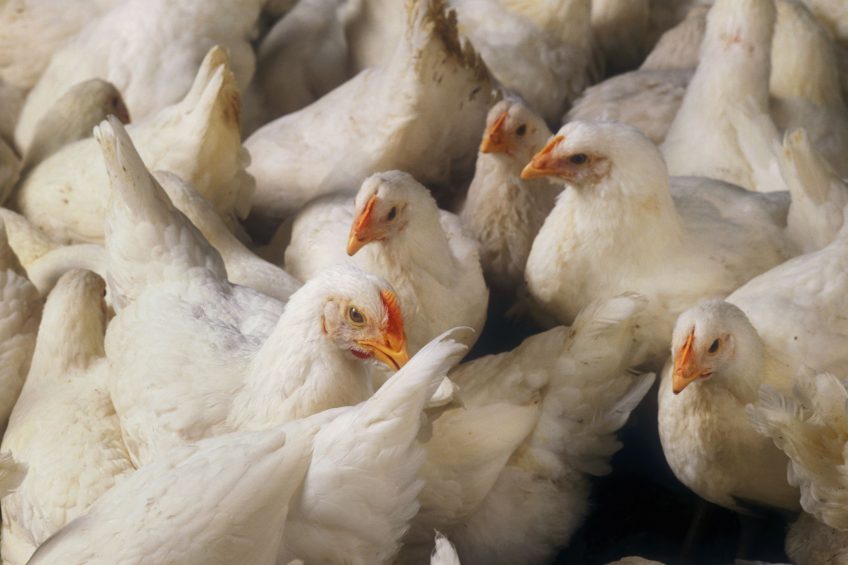Concerns rising over effective poultry stunning

Concern is growing over the number of poultry being slaughtered without an effective stun.
Government figures suggest that around 180 million (m) chickens and other poultry were killed last year using an electric shock that vets deem insufficient to guarantee unconsciousness due to a loophole in the law.
Figures show that while 20% of chickens were slaughtered under religious rites last year, less than 5% of the population – followers of Islamic and Jewish law – need to buy meat produced in this way.
A total of 91m poultry were either stunned inefficiently or not stunned at all because of religious rites between April and September 2017 – and 180m chickens, turkeys and other poultry are estimated to have been slaughtered in this year during the year, according to the Food Standards Agency. The FSA suggests most poultry slaughtered in this way are not being killed for religious purposes at all, and are suffering avoidably painful deaths.
The Independent said this week that both former Labour shadow agriculture secretary Kerry McCarthy and influential veteran Labour EFRA committee member Paul Flynn would raise the issue at future committee meetings.
Inadequate stunning a major welfare issue
Gudrun Ravetz, BVA senior vice president, told the paper: “This increase in the number of poultry that are not sunned or not stunned effectively before slaughter is a grave concern. Millions of individual animals are affected, making this a major animal welfare issue.
“The lack of evidence-based parameters for waterbath stunning of poultry means English regulations are simply not fit for purpose, and could call into question our claim as a leader in high animal welfare.”
Stunning: Physiological v neurological indicators
Richard Griffiths, British Poultry Council chief executive, said in a blog published last month that effective stunning of poultry prior to slaughter was absolutely essential and offered the best welfare option.
Mr Griffiths said an effective stun delivered, in broad terms, insensibility to pain: “The science of an effective stun was historically based on physiological indicators, but the current approach relied more on neurological ones.
“This is an area of science that is still progressing, and our understanding is frequently moving forward. Given our scientific knowledge we can say that electrical stunning, applied correctly and to defined standards, delivers an effective stun.”
Religious rites: Non-stun slaughter
The exemption to the Welfare at the Time of Killing (WATOK) Regulations on religious rites grounds permits slaughter of poultry without using stunning. This non-stun slaughter is relatively easy to define, and both Judaism and Islam have their own procedures that cover how this is applied.
The Regulation contains a set of electrical parameters to be used with different species of poultry. These parameters sent boundaries for voltage, current and frequency and combinations of these are used to deliver what is referred to as an effective stun. Religious slaughter that allows stunning uses the second, recoverable stun. Non-religious slaughter mostly uses stun to kill and there are combinations of the electrical parameters that have, through scientific study, been proven effective.
Inconsistency with the Regulation
But he added there was a serious inconsistency with the Regulation: “If a regular, non-religious, producer wanted to stun poultry using a new combination of electrical parameters, the burden of proof would be put on the producer to provide scientific evidence that what they are proposing would deliver an effective stun.
“Conversely, a producer operating under the exemption for religious rites can use any combination of electrical parameters. In this instance the burden of proof falls on the regulator (Food Standards Agency/Defra) to demonstrate that the practice causes … avoidable pain, distress or suffering. Given that modern indicators of an effective stun are neurological and can only be measured in a laboratory environment, it is massively unfair to expect regulators and vets to be able to do this in a slaughterhouse,” he added.
Concerns about electric water bath systems
The RSPCA has expressed its concern over the “complex” problems involved with the stunning of poultry. It has particular concerns about the use of electric water bath systems, which it says:
- Involve the shackling of live birds – which is painful
- Can result in some birds missing the water bath stunner
- Can result in the birds receiving painful pre-stun shocks as they enter the stunner
- Can result in an insufficient electrical current flowing through the bird’s body to ensure the birds is unconscious
- Can be designed so birds passing through an automatic neck cutter only receive a single cut to the neck, which reduces the rate of blood loss
- Can result in birds accidentally missing the automatic neck cutter. If these birds are not noticed by the slaughter person, they may still be alive when entering the scalding tank.












